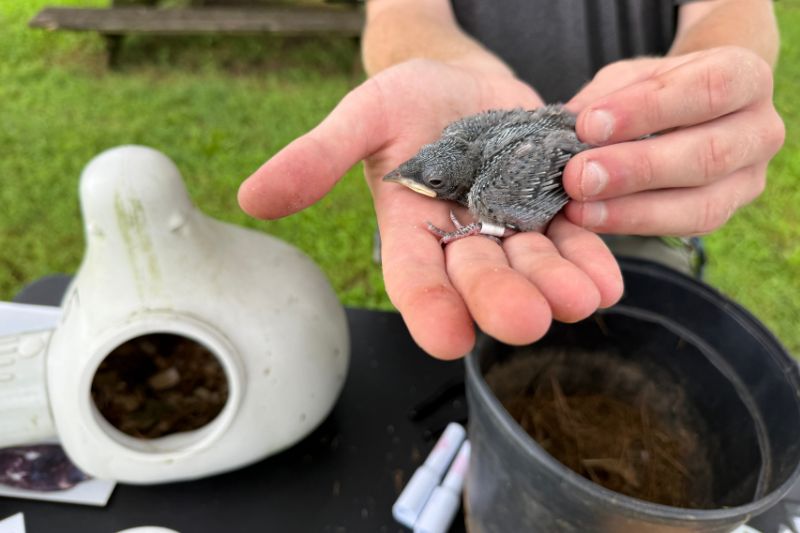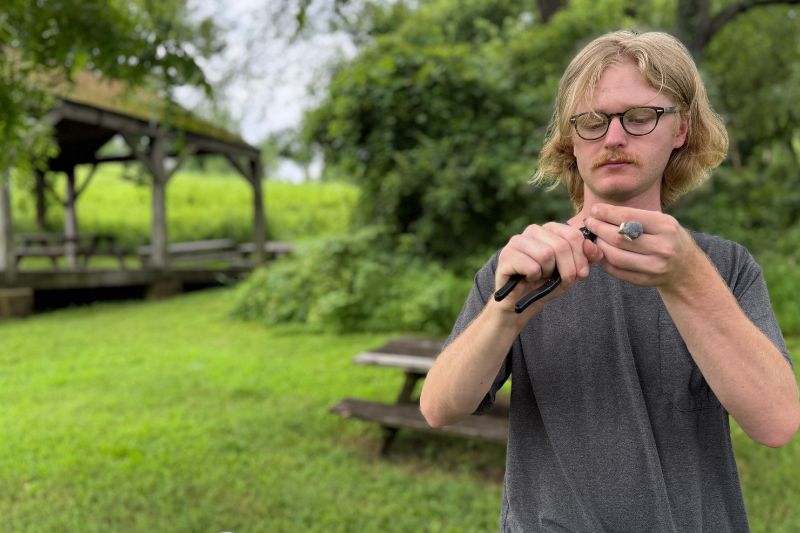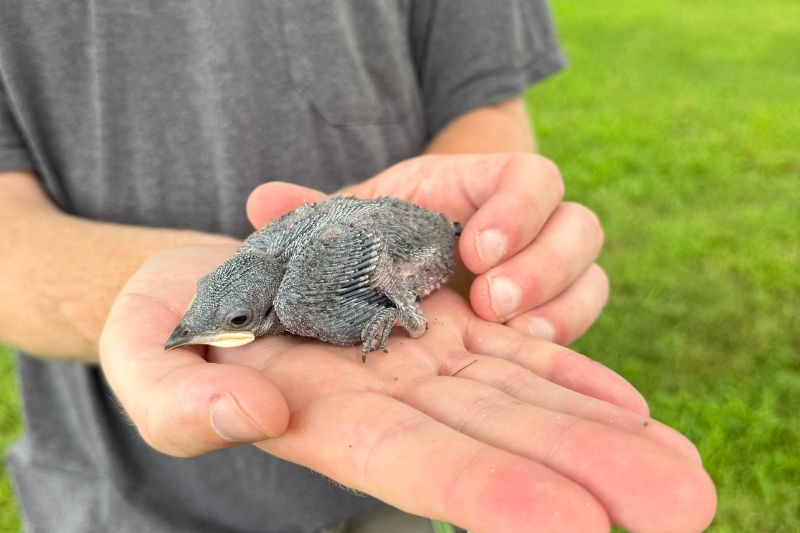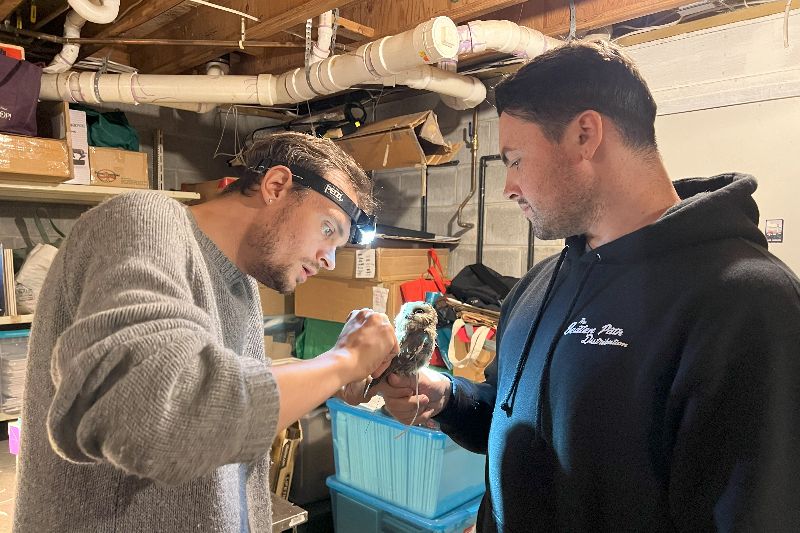


Bird conservation
Photos by Katie Peikes and courtesy of Aaron Coolman August 29, 2025
UD graduate students study birds of concern to help their populations bounce back
On a warm July morning, Will Krohn gingerly gripped a small pair of pliers in one hand and a newly hatched bird in the other. With the chick peeking its head out between two of Krohn’s fingers, Krohn gently attached a tiny metal band to its right leg.
“It’s like a social security number for a bird,” said Krohn, a University of Delaware master’s student studying wildlife ecology.
These purple martins were just a couple weeks old, hatched from manmade nest colonies at Ashland Nature Center in Hockessin, Delaware.
Krohn equipped each hatchling with a metal band on one leg and two white plastic bands on the other. Alongside partners at the Delaware Nature Society, the Delaware Audubon Society, the Purple Martin Conservation Association, and the Pennsylvania Game Commission, Krohn will track where the purple martins go after hatching — called natal dispersal. The data will help his master’s thesis.
Krohn’s research is tackling a bird experiencing population decline, considered a species of conservation concern. It’s not the only UD summer research investigating birds with conservation implications. Two other UD graduate students are studying grassland songbirds and northern saw-whet owls. The data could influence efforts to protect and manage these species.

How far do baby purple martins settle from their nests?
Natal dispersal is a hot topic in wildlife ecology. It helps shed light on how animal populations maintain themselves.
If birds don’t disperse after hatching, they risk mating with close relatives. That could hinder their own offspring from reproducing in the long term and maintaining genetic diversity, a key factor in species’ ability to persist and adapt to changing climates.
“Natal dispersal is kind of wrapped up in the success of the species as a whole,” Krohn said. “When we have more martins and martins are distributed more widely throughout the area, they are a more effective indicator of ecosystem health at large.”
Since purple martins eat a lot of insects, a declining population could be a product of insect decline, as insect populations are already sharply decreasing around the world.
“If that’s happening, then we’re losing ecosystem services, like pollination,” Krohn said. “We could see pests like mosquitoes become out of control as a result of the collapse of the insect food web.”

How does habitat influence grassland songbirds’ nesting?
For her research, UD wildlife ecology master’s student Grace Muench is studying grassland songbirds and how they move within their environment during the breeding season.
Meunch’s research is based at Letterkenny Army Depot in Pennsylvania. She is studying the Eastern towhee, the yellow-breasted chat, and the gray catbird, and how they interact with early successional habitats like agricultural fields, pollinator fields or young forests. The environments usually have a lot of plants rapidly growing, recovering after a disturbance, like extreme weather.
"Many shrubland bird species have historically depended on early successional habitats as breeding grounds,” Muench said. “They’ve evolved to breed in these dynamic environments and generally do not use more mature forest or open habitats. As these early-stage habitats become increasingly rare, especially due to land-use change and fire suppression, species like the yellow-breasted chat face the risk of population declines simply because suitable breeding areas are disappearing.”
Muench is catching birds using very fine mesh nets, and putting small radio tags on them to track them. She started tagging birds in March 2024 and hopes to tag 300.
As the Pennsylvania Game Commission looks to create more early successional habitats, Muench’s research could help inform habitat management by identifying species-specific habitat preferences and evaluating responses to different management practices.
“These birds are declining across Pennsylvania and rely on early successional habitat to breed and succeed,” Muench said. “If we want to help these birds in other parts of their range, we need to know what kind of land management practices work for them.”
What can we learn about owl migration patterns by using radio tags?
UD wildlife ecology master’s student Aaron Coolman is researching northern saw-whet owls. These small, nocturnal owls are about the size of a soda can. They breed in remote areas like boreal forests throughout Canada and Appalachian forests, particularly those of higher elevations or dense canopies, making them highly elusive for researchers to study.
As land use and management practices evolve, saw-whets face increasing threats to their primary breeding and wintering areas. Timber harvest, increasing forest fires, and peat-bog harvest pose a threat to northern saw-whet owls because they can damage and eliminate their habitat.

Coolman studies the owls’ movement patterns during their spring and fall migrations to elucidate migration corridors, timing, and patterns. From September through December, Coolman and collaborators capture northern saw-whet owls in eastern Ontario, northern Quebec, coastal Maine, and eastern Pennsylvania. Coolman plays a saw-whet lure — a territorial call — from a speaker, to draw owls to his net. After catching an owl, he’ll place a radio tracking device on it to gather data on their movement patterns.
“A part of it is to fill in the unknown aspects of their natural history,” Coolman said. “The better we understand this species, the better we can conserve it.”
The more information researchers have, the more thorough recommendations they’ll be able to make to land managers about the owls and their habitat.
Coolman has already tagged more than 130 saw-whets since July of 2024.
A common thread
Coolman, Muench and Krohn’s projects are part of University of Delaware wildlife ecology professor Jeffrey Buler’s Aeroecology Lab.
“A lot of the questions we’re investigating are what we would call applied questions with conservation implications,” Buler said. “We are trying to better understand when their populations are limited. Knowing that, then we could develop mitigation efforts or conservation efforts to then try to address those issues.”
The species are tied together by movement ecology and conservation. Movement ecology focuses on where migrating birds go and how they’re affected. If researchers can monitor where birds are going, they can help draft conservation strategies to help species thrive.
Buler said each species has its own ecological niche, meaning they’re an important part within the web of species.
“The ecosystems are these complicated webs,” Buler said. “If you start removing some of those species, at some point the ecosystem can break down.”
Buler’s lab has studied purple martins since 2020, after the Delaware Audubon Society came to him interested in studying this bird’s movement. With Krohn’s research, Buler said, ultimately the Pennsylvania Game Commission hopes to place new manmade colonies for purple martins in spots where the birds are more likely to find them. Purple martins historically occupy only manmade colonies, something unique to this bird in the Eastern U.S.
“We're trying to better understand how birds find new colonies and colonize these new colonies, and what attributes about a colony make it more attractive so they can maximize the number of birds they could support,” Buler said.
Back at Ashland Nature Center, Will Krohn said he hopes to band 750 purple martin chicks this year and 750 more next year, between the Hockessin nature center and several locations in Pennsylvania.
“It’s a really exciting project to be a part of,” Krohn said. “I’m excited to see some data come in next year.”
Contact Us
Have a UDaily story idea?
Contact us at ocm@udel.edu
Members of the press
Contact us at mediarelations@udel.edu or visit the Media Relations website

